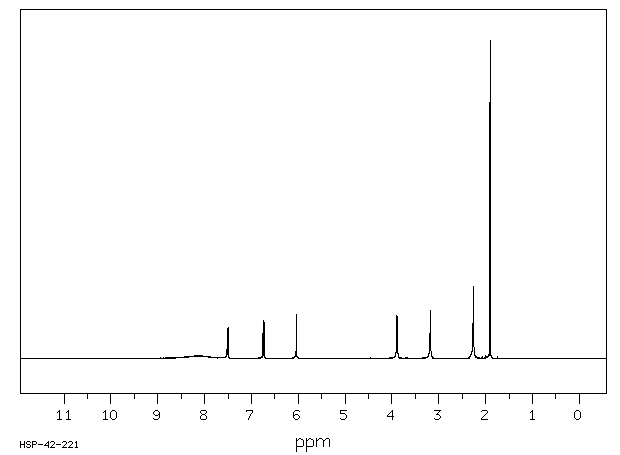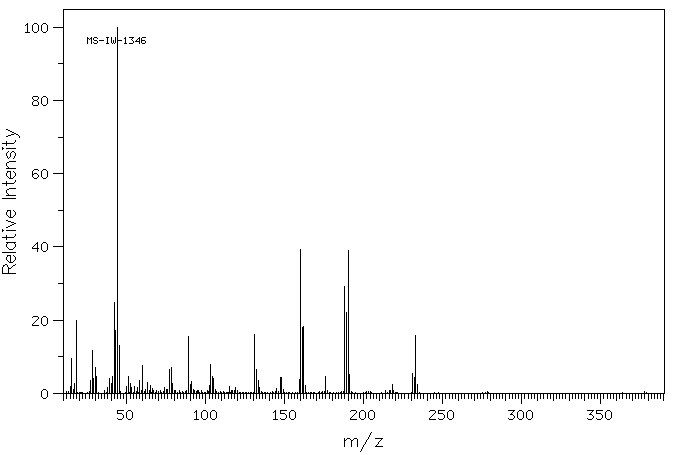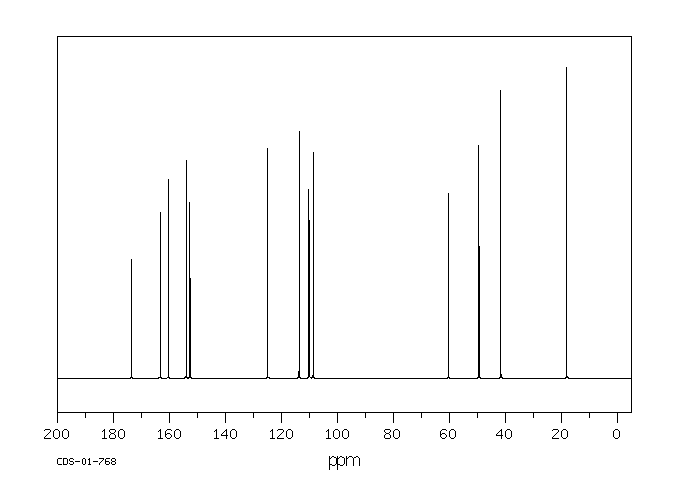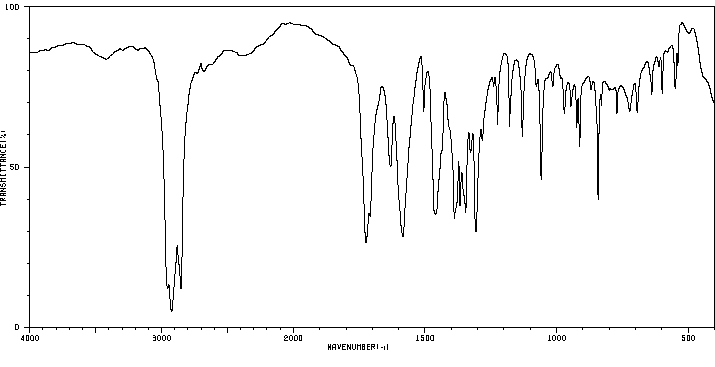甲基钙黄绿素 | 54696-41-2
中文名称
甲基钙黄绿素
中文别名
——
英文名称
4-methyl-8-(carboxymethyl-N-methyl)aminomethyl umbelliferrone
英文别名
Methylcalcein Blue;MCB;2-[(7-Hydroxy-4-methyl-2-oxochromen-8-yl)methyl-methylazaniumyl]acetate
CAS
54696-41-2
化学式
C14H15NO5
mdl
——
分子量
277.277
InChiKey
MGGUJKYUDQUTSV-UHFFFAOYSA-N
BEILSTEIN
——
EINECS
——
-
物化性质
-
计算性质
-
ADMET
-
安全信息
-
SDS
-
制备方法与用途
-
上下游信息
-
文献信息
-
表征谱图
-
同类化合物
-
相关功能分类
-
相关结构分类
物化性质
-
熔点:180 °C (dec.)(lit.)
-
稳定性/保质期:
遵照规定使用和储存,则不会分解。
计算性质
-
辛醇/水分配系数(LogP):-1.4
-
重原子数:20
-
可旋转键数:4
-
环数:2.0
-
sp3杂化的碳原子比例:0.29
-
拓扑面积:87.1
-
氢给体数:2
-
氢受体数:6
安全信息
-
海关编码:2932209090
上下游信息
-
上游原料
中文名称 英文名称 CAS号 化学式 分子量 羟甲香豆素 7-hydroxy-4-methyl-chromen-2-one 90-33-5 C10H8O3 176.172
反应信息
-
作为反应物:描述:copper(II) choride dihydrate 、 甲基钙黄绿素 在 sodium hydroxide 作用下, 以 sodium hydroxide 为溶剂, 生成 [Cu(Methyl Calcein Blue)](2+)参考文献:名称:利用金属-染料复合物的动态组合库检测肽激素:时间分辨测量的优势†摘要:金属-染料配合物的动态组合库是通过使染料甲基钙黄绿素蓝,Arsenazo I和 二甲苯酚橙用CuCl 2和NiCl 2。加入肽激素后,混合物会产生特征性的UV-Vis反应血管紧张素 我和 血管紧张素II。这样可以从混合物中区分出纯的肽激素样品。在库的平衡过程中执行几次UV / Vis测量时,传感器的辨别能力得到了增强。DOI:10.1039/b912400d
-
作为产物:参考文献:名称:Activity of Mannich bases of 7-hydroxycoumarin against Flaviviridae摘要:Some Mannich bases of 7-hydroxycoumarin (2) and their simple derivatives (3 and 4) were prepared and tested against viruses containing single-stranded, positive-sense RNA genomes (ssRNA(+)). This study was directed toward Flaviviridae and, in particular, HCV surrogate viruses (BVDV, YFV). The 7-hydroxy derivatives 2 were generally devoid of activity, but when position 7 was propylated, the resulting 7-propyloxy derivatives 3 were in some cases endowed with an interesting activity against BVDV. The formation of 7-benzoyl derivatives 4 gave compounds generally lacking in activity against Flaviviridae, whereas the appearance of activity against RSV has been observed. Also some unsymmetrical methylene derivatives 5-7 (namely coumarins bridged to chromones or indoles) were found moderately active in antiviral tests. Derivatives 3 were submitted to a molecular modeling study using DNA polymerase of HCV as a target. The good correlation between calculated molecular modeling IC50 and experimental EC50 indicates that DNA polymerase is potentially involved in the inhibition of surrogate HCV viruses. (C) 2007 Elsevier Ltd. All rights reserved.DOI:10.1016/j.bmc.2007.11.045
文献信息
-
Kinetics and mechanism of complex formation reaction of iron(III) with 4-methyl-8-(carboxymetahyl_aminomethyl umbelliferrone and related ligands: role of substituent groups on nitrogen donor atoms on the reaction作者:Hiroto Yoshida、Tomohiro Ozawa、Koichiro Jitsukawa、Hisahiko EinagaDOI:10.1016/s0277-5387(00)84322-3日期:1993.6donations of the amino nitrogen and carboxylato oxygen(s) to form a mono_terdentato- and tetradentato)iron(III) complex was deduced as the reaction mechanism. The possibility of changing the thermodynamic stability with no variation in the reaction mechanism by the introduction of substituent groups on the amino nitrogen of 1 is suggested.摘要研究了4-甲基-8-(羧甲基)氨基甲基伞形酮(1,H2mug)及其N-甲基(2,H2mugm)和N-羧甲基(3,H3muia)衍生物的铁(III)配合物的形成。在25°C下在硝酸钠水溶液(0.10 mol dm-3)中进行分光光度法。1:1(金属:配体)络合物对于所有三个配体唯一形成,表明配位配体和配位配体之间存在空间干扰。稳定常数[logβ11/(mol-1 dm3(])对于4 [Fe(mugm +)]为15.74±0.20,对于5 [Fe(mugm +)]为15.69±0.20,对于6 [Fe为18.67±0.20复合物的形成反应是通过Fe3 +和Fe(OH)2+的两个平行途径进行的,双质子化配体分别为1、2和3;酚基氧的缓慢配位,然后推导了氨基氮和羧基氧的快速捐赠形成单叔齿和四齿铁(III)配合物作为反应机理。建议通过在1的氨基氮上引入取代基来改变热力学稳定性而不改变反应机理的可能性。
表征谱图
-
氢谱1HNMR
-
质谱MS
-
碳谱13CNMR
-
红外IR
-
拉曼Raman
-
峰位数据
-
峰位匹配
-
表征信息
同类化合物
黄皮香豆精
黄木亭
黄曲霉素P2
黄曲霉素P1
黄曲霉素G2-13C17-同位素
黄曲霉素G2
黄曲霉素G1-13C17-同位素
黄曲霉素B2-13C17-同位素
黄曲霉素B1-13C17-同位素
黄曲霉素B1 8,9-环氧化物
黄曲霉素 G1
黄曲霉毒醇Ⅱ
黄曲霉毒醇M1
黄曲霉毒醇A
黄曲霉毒素M2
黄曲霉毒素M1-(O-羧甲基)肟
黄曲霉毒素G2a
黄曲霉毒素G19,10-环氧化物
黄曲霉毒素B2
黄曲霉毒素B1二氯化物
黄曲霉毒素B1-8,9-二氯化物
黄曲霉毒素B1-(O-羧甲基)肟
黄曲霉毒素 Q1
黄曲霉毒素 M1
黄曲霉毒素 B2
黄曲霉毒素 B1
黄曲霉毒素
香豆霉素
香豆素6H
香豆素545T
香豆素545
香豆素525
香豆素343甲酯
香豆素338
香豆素314T
香豆素175
香豆素152
香豆素106
香豆素-D4
香豆素-6-磺酰氯
香豆素-6-甲醛
香豆素-5-氧丁酸
香豆素-4-乙酸
香豆素-3腈
香豆素-35
香豆素-3-羧酸酸酐
香豆素-3-羧酸琥珀酰亚胺酯
香豆素-3-羧酸乙酯
香豆素-3-羧酸
香豆素-3-甲酰氯










